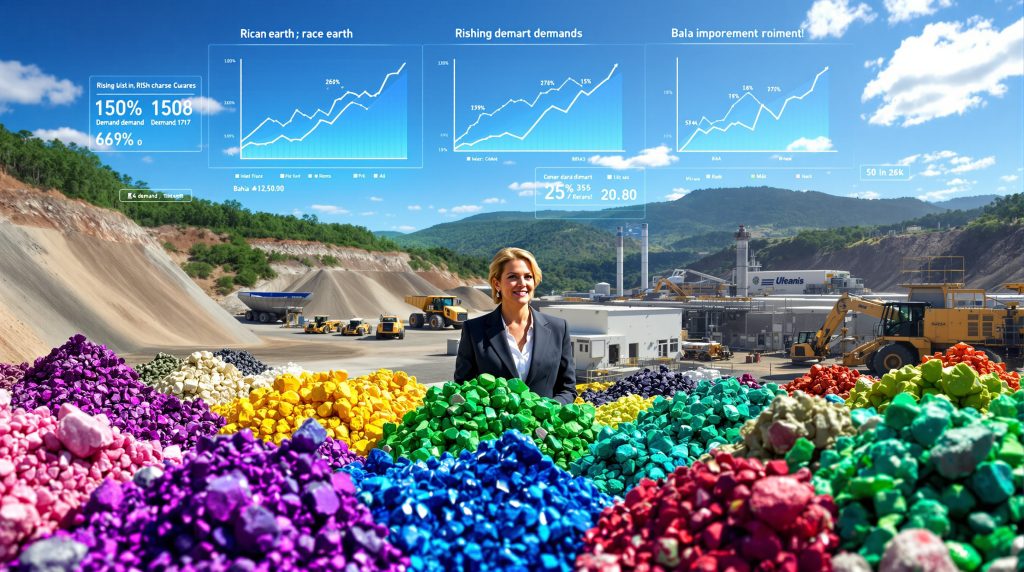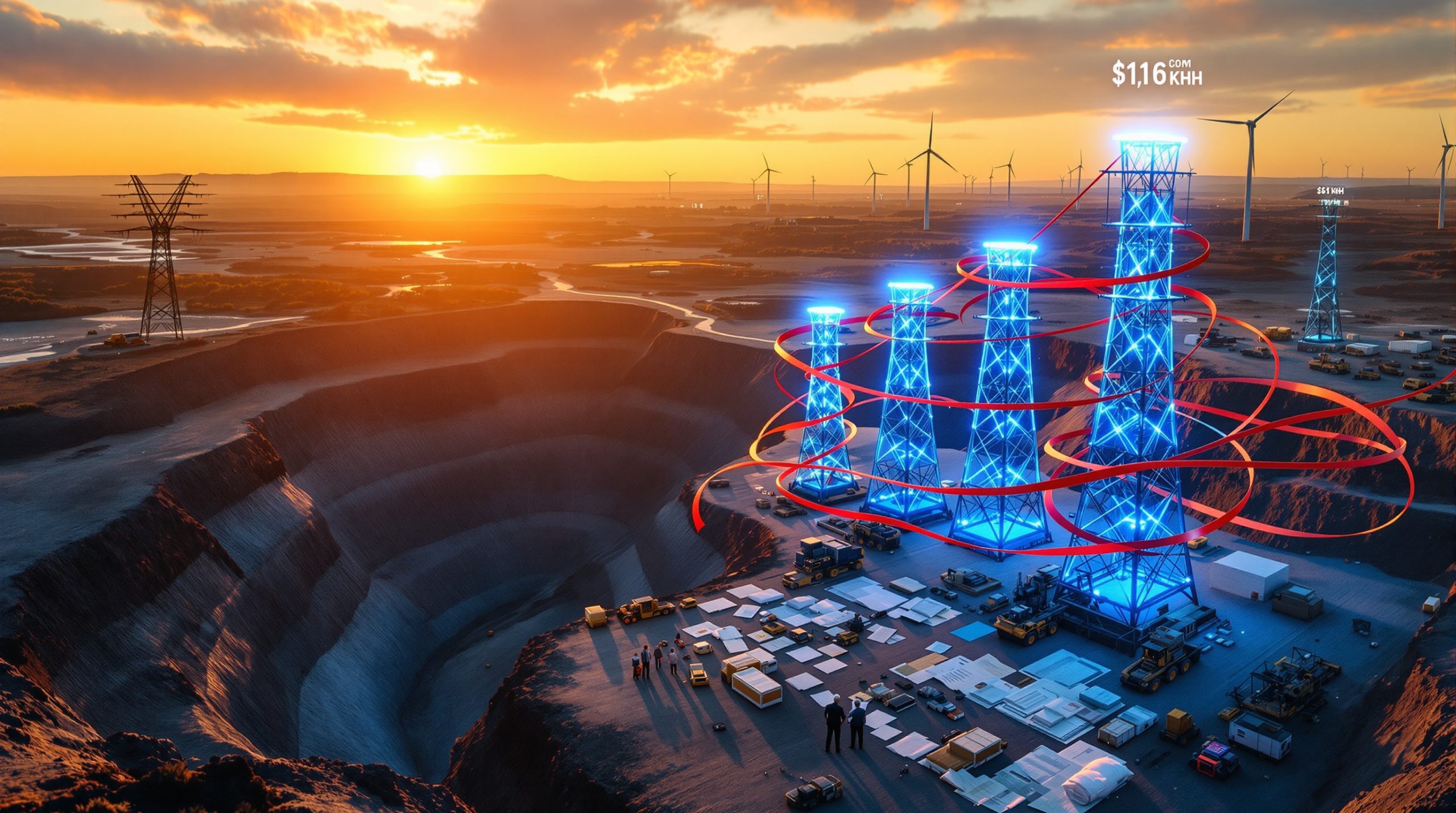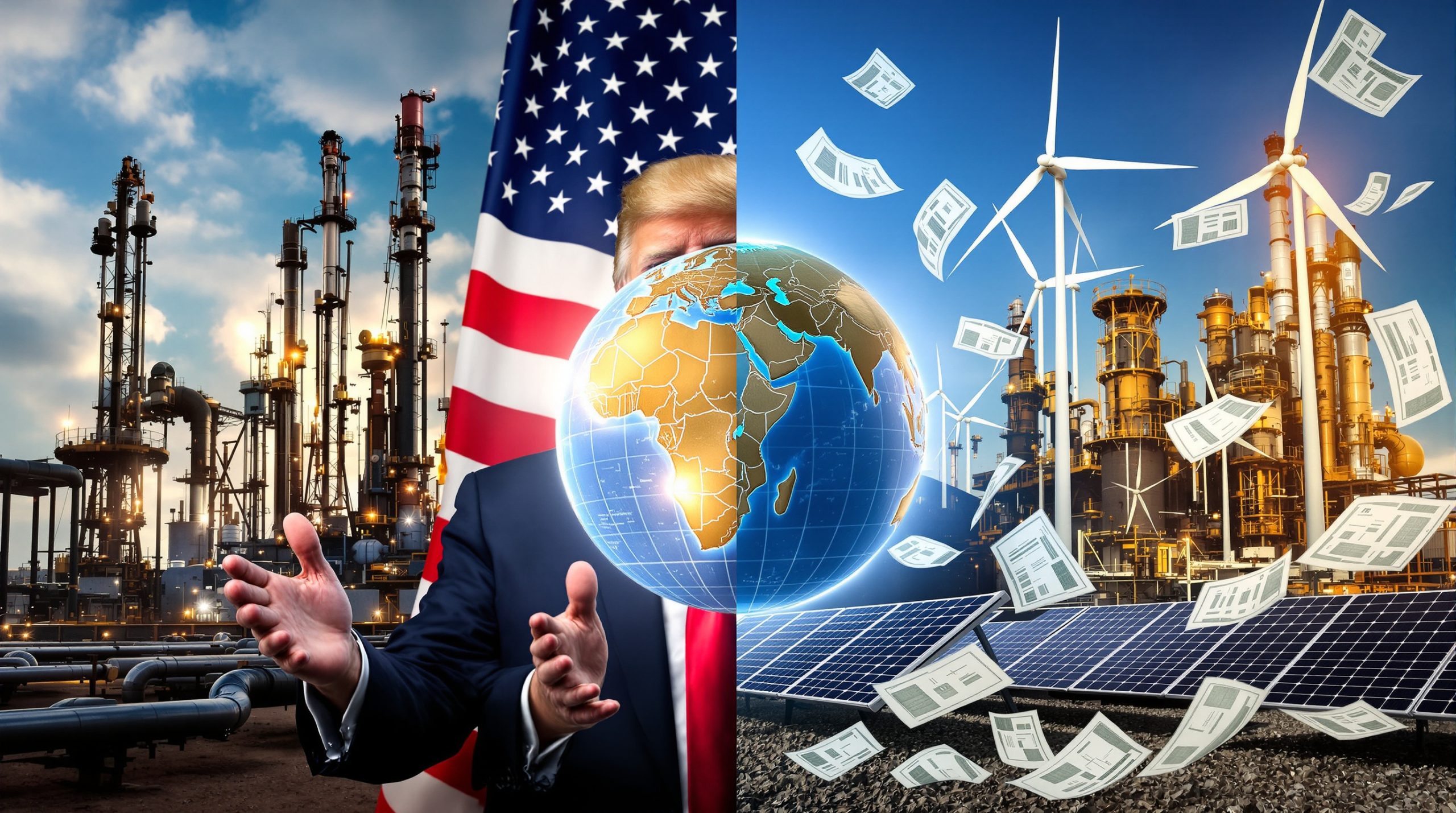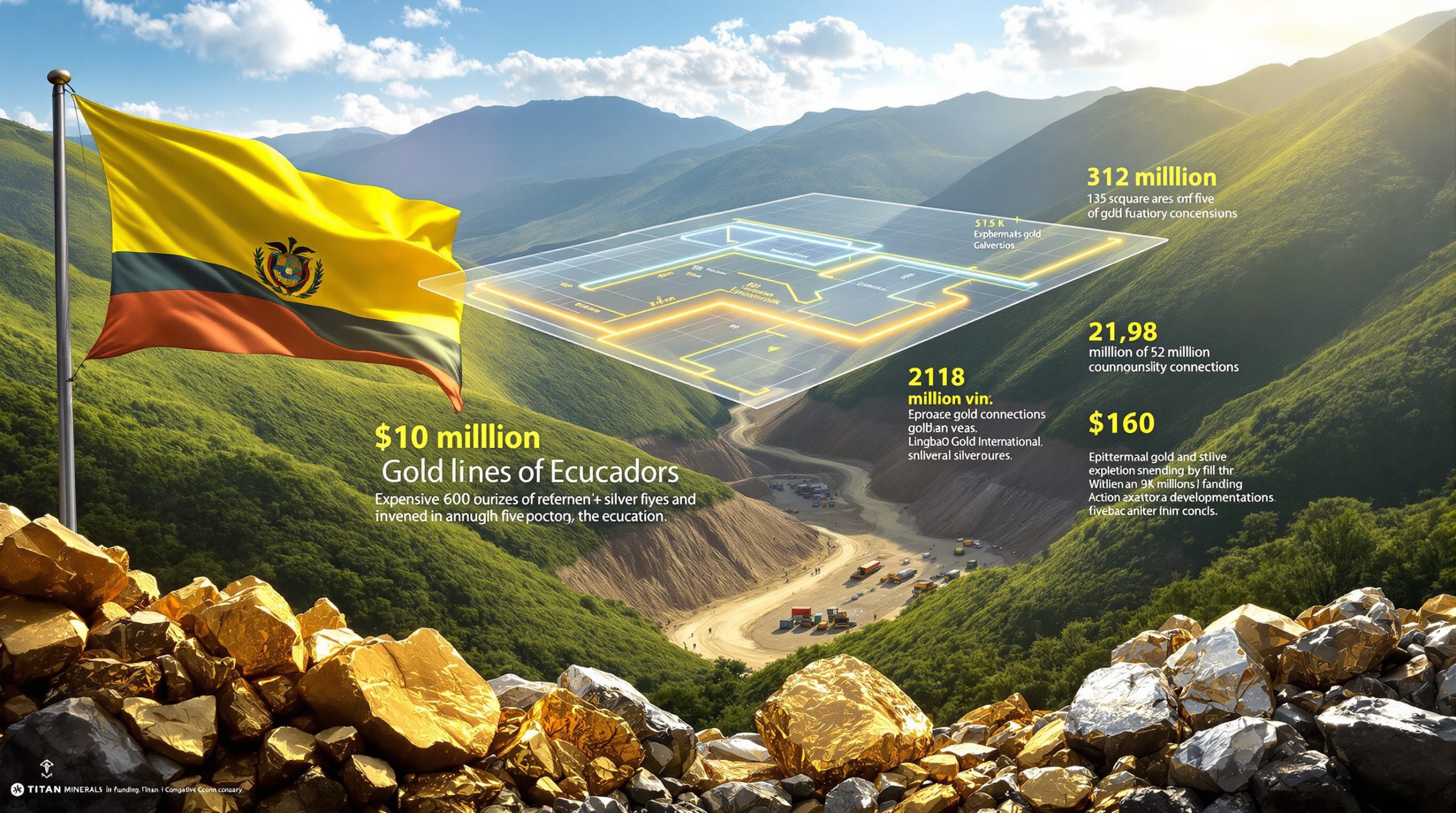Brazilian Rare Earths: Gina Rinehart's Strategic Investment in Critical Minerals
Brazil is emerging as a critical player in the global rare earths market, offering significant geological advantages and strategic benefits for Western supply chains. The country's northeastern region, particularly Bahia state, contains substantial rare earth deposits with favorable infrastructure access. As global demand for these critical minerals continues to grow, driven by clean energy technologies and defense applications, Brazil's rare earth sector is attracting major investment from international mining figures like Gina Rinehart.
Brazil's Rare Earth Potential: By the Numbers
Brazil holds approximately 21 million metric tons of rare earth oxide reserves, making it the world's second-largest reserve holder after China, according to the United States Geological Survey. Despite these substantial resources, Brazil currently accounts for less than 1% of global rare earth production, indicating enormous growth potential in this strategic sector.
The country's geological advantages are substantial, with Brazilian deposits containing high concentrations of valuable heavy rare earth elements. These deposits are predominantly hosted in alkaline intrusive complexes and carbonatites, similar to successful operations globally.
Brazilian rare earth projects benefit from existing infrastructure, including established power grids, road networks, and port facilities in the northeastern region. The Port of Aratu, located approximately 200km from interior mining regions, provides a crucial export gateway for future production.
The regulatory environment has become increasingly supportive of critical mineral development. The Brazilian government's National Mining Plan 2030 identifies rare earth elements as strategic minerals and prioritizes related infrastructure development, creating a favorable framework for investment.
Brazil's emergence as a rare earth producer offers Western nations a compelling alternative to Chinese-dominated supply chains. With China controlling approximately 70% of global rare earth mining and 90% of processing capacity as of 2025, Brazil represents a potential strategic counterweight to ensure energy transition security.
Who is Gina Rinehart and Why is She Investing in Brazilian Rare Earths?
Australia's Mining Magnate Expands Her Portfolio
Gina Rinehart, Australia's wealthiest individual with an estimated net worth of AUD $36.9 billion (as of October 2025), built her fortune primarily through iron ore mining in Western Australia. As chair of Hancock Prospecting, she has strategically diversified her mining interests in recent years, with rare earth elements becoming a significant focus.
Rinehart's flagship company, Hancock Prospecting, produces approximately 60 million tonnes of iron ore annually through its joint ventures including Roy Hill. This operational expertise in large-scale mining provides a strong foundation for evaluating and developing new resource opportunities.
Her investment strategy reflects a broader recognition of rare earths' growing importance in global technology supply chains. By acquiring stakes in multiple rare earth companies across different jurisdictions, Rinehart has created a diversified portfolio that spans the entire value chain from mining to processing.
Strategic Diversification Beyond Iron Ore
Rinehart has established an impressive track record developing large-scale resource projects, particularly in the Pilbara region of Western Australia. Her operational approach typically involves tight cost control, technological innovation, and strategic partnerships to maximize project value.
Through Hancock Prospecting, Rinehart has acquired a 5% stake in Brazilian Rare Earths, adding to a growing portfolio of critical minerals investments. This strategic position gives her exposure to one of the most promising rare earth developments outside China.
Her investment pattern shows a clear focus on companies with strategic value to Western supply chains. Beyond Brazilian Rare Earths, she holds positions in MP Materials Corp. (US-based rare earth producer operating the Mountain Pass mine) and Lynas Rare Earths Ltd. (Australian rare earth miner with processing operations in Malaysia).
This diversification strategy mirrors broader industry trends. According to S&P Global Market Intelligence, global investment in rare earth projects increased by 156% year-over-year in 2024-2025 as companies and investors position themselves in this growing market and develop junior mining strategies.
How Significant is Brazilian Rare Earths' Recent Capital Raise?
Breaking Down the $78 Million Funding Round
Brazilian Rare Earths Ltd. successfully raised A$120 million ($78 million) through a new share placement in October 2025. This capital raise represents a significant vote of confidence in the company's development plans and strategic direction. The funding will accelerate the development timeline for the Rocha da Rocha project and associated processing facilities.
The company received "firm commitments" for a placement of 25.6 million shares at A$4.68 per share, representing a modest 6.4% discount to its previous closing price. This relatively small discount compared to the industry average of 8-12% indicates strong investor demand for the offering.
Before entering a trading halt for the capital raise, the Gina Rinehart-backed Brazilian rare earth miner had a market value of approximately A$1.24 billion, reflecting substantial investor interest in the company's projects and strategic positioning.
Key Details of the Capital Raise:
| Aspect | Details |
|---|---|
| Total Amount Raised | A$120 million ($78 million) |
| Share Price | A$4.68 per share |
| Discount to Previous Close | 6.4% |
| Number of New Shares | 25.6 million |
| Market Response | 9% share price increase following announcement |
| Pre-Raise Market Valuation | Approximately A$1.24 billion |
Market Reaction and Investor Confidence
The market responded positively to the capital raise, with shares surging up to 12% upon reopening of trading. After the initial surge, shares were trading 9% higher at A$5.45 as of 10:09 a.m. in Sydney on the announcement day, demonstrating continued investor enthusiasm.
This enthusiastic reception indicates strong investor confidence in both the company's projects and the broader rare earths sector. The successful raise positions Brazilian Rare Earths with a substantial war chest to advance its development plans without immediate additional funding needs.
The company's ability to raise capital at a relatively small discount during a period of market volatility further validates its business model and growth strategy. According to industry analysts, this successful financing represents one of the larger capital raises in the rare earth sector in 2025, highlighting Brazilian Rare Earths' prominent position among development-stage companies.
What is the Rocha da Rocha Project?
Exploring Brazil's Premier Rare Earth Development
The Rocha da Rocha project, located in Bahia state in northeastern Brazil, represents one of the most promising rare earth developments outside China. The project benefits from exceptional geological characteristics and strategic infrastructure advantages that position it favorably compared to many competing projects globally.
Bahia state hosts several carbonatite complexes known to contain rare earth mineralization, creating a geological environment similar to successful rare earth operations globally. These geological characteristics suggest potential for high-grade resources with favorable mining conditions.
The project benefits from established infrastructure in Bahia state, including access to the Port of Aratu (approximately 200km from interior mining regions), Salvador International Airport, federal highways BR-116 and BR-242, and existing power transmission networks.
Project Highlights:
- Location: Bahia state, northeastern Brazil
- Resource Type: High-grade rare earth deposits in carbonatite complex
- Infrastructure: Access to existing transportation networks and power supply
- Development Stage: Advanced exploration with fast-tracked development timeline
- Strategic Importance: Potential major non-Chinese supply source for critical rare earths
While detailed resource estimates have not yet been publicly disclosed, the company has described the deposits as "ultra-high-grade," suggesting concentrations that could support competitive production costs. The project's development is being accelerated following the recent capital raise, indicating the company's confidence in its economic potential.
How Will the New Funding Accelerate Development?
Fast-Tracking Project Development and Processing Capabilities
The newly secured funding will enable Brazilian Rare Earths to accelerate its development timeline across multiple fronts. The company has explicitly stated that the capital will be used to "fast-track development of ultra-high-grade rare earth projects in Brazil and compress timelines for the planned integrated rare earths separation refinery at Camaçari, Bahia."
This acceleration is strategically important in the rare earth sector, where typical development timelines extend 7-10 years from discovery to production, with processing facilities adding another 2-3 years to development schedules. By compressing these timelines, Brazilian Rare Earths aims to capture market share during a period of growing demand and limited new supply.
Key Development Priorities:
-
Accelerated Exploration: Expanding drilling programs to further define resource boundaries and upgrade resource classifications
-
Technical Studies: Completing feasibility studies and engineering designs to establish project economics and operational parameters
-
Permitting Process: Advancing regulatory approvals for mining and processing operations through Brazil's environmental and mining authorities
-
Processing Facility: Developing the planned rare earth separation refinery at Camaçari, Bahia
-
Infrastructure Development: Enhancing site access and operational capabilities to support future mining activities
The aggressive development approach reflects both the strategic importance of rare earth elements and the company's confidence in the project's fundamental economics. By accelerating multiple workstreams simultaneously, Brazilian Rare Earths aims to significantly reduce the typical development timeline for rare earth projects.
What Makes the Camaçari Refinery Strategically Important?
Building Vertical Integration in the Rare Earth Supply Chain
The planned integrated rare earths separation refinery at Camaçari represents a critical strategic advantage for Brazilian Rare Earths. Most rare earth projects globally lack access to processing facilities outside China, creating a significant bottleneck in supply chains. By developing its own separation capabilities, the company aims to create a more complete value chain.
The Camaçari Industrial Complex provides an ideal location for rare earth processing, offering established industrial infrastructure. As one of Latin America's largest integrated industrial complexes, Camaçari hosts over 90 chemical and petrochemical companies with existing natural gas supply infrastructure, industrial water treatment facilities, and chemical processing expertise.
Developing separation capacity outside China requires significant capital investment, typically $200-500 million for commercial-scale facilities. The recent funding provides initial capital toward this strategic objective, though additional financing will likely be required as the project advances.
Strategic Benefits of Vertical Integration:
-
Supply Chain Control: Reduced dependence on third-party processors creates greater operational independence
-
Value Addition: Ability to produce higher-value separated rare earth products rather than selling intermediate concentrates
-
Market Access: Direct relationships with end-users of specific rare earth elements creates marketing advantages
-
Strategic Positioning: Alternative to Chinese-dominated processing capacity benefits Western supply chains
-
Economic Benefits: Higher margins compared to selling unprocessed materials improves project economics
According to the International Energy Agency, approximately 90% of global rare earth refining capacity is located in China, creating significant supply chain vulnerabilities for Western economies. The development of processing capacity in Brazil would represent a meaningful step toward supply chain diversification and complement the planned European CRM facility.
Why are Rare Earth Elements Strategically Important?
Critical Applications Driving Global Demand
Rare earth elements play an essential role in numerous high-tech applications, particularly in clean energy technologies and defense systems. Their unique magnetic, catalytic, and luminescent properties make them irreplaceable in many advanced technologies.
The market for these critical minerals continues to expand rapidly. According to the International Energy Agency, global demand for rare earth elements in electric vehicle applications alone is projected to grow from approximately 10,000 tonnes in 2024 to over 40,000 tonnes by 2030, representing a 400% increase.
Wind energy represents another major growth market. The Global Wind Energy Council projects that permanent magnet wind turbine installations will require approximately 15,000-20,000 tonnes of rare earth elements annually by 2030, up from approximately 8,000 tonnes in 2024.
Defense applications further drive demand. The U.S. Department of Defense has designated rare earth elements as critical materials for national security, with applications in precision-guided munitions, radar systems, and electronic warfare equipment.
Key Applications Driving Demand:
-
Electric Vehicles: Permanent magnets for motors require 2-3 kg of neodymium and praseodymium per vehicle
-
Wind Turbines: High-performance generators contain 200-600 kg of rare earth elements per turbine depending on size
-
Electronics: Smartphones, computers, and displays utilize multiple rare earths for displays, speakers, and vibration motors
-
Defense Systems: Guidance systems, radar, and night vision equipment rely on samarium, yttrium, and other rare earths
-
Catalysts: Petroleum refining and emissions control systems use lanthanum and cerium as critical catalyst components
The U.S. Geological Survey emphasizes that rare earth elements are essential for modern technologies and defense systems, with no known substitutes for many applications, making supply chain security for these materials a national priority.
How Does Gina Rinehart's Investment Strategy Target Critical Minerals?
Building a Strategic Portfolio of Rare Earth Assets
Rinehart's investment in Brazilian Rare Earths represents part of a broader strategy to position Hancock Prospecting in the critical minerals sector. Through strategic investments in multiple rare earth companies, she has established a significant presence in this growing market.
Her multi-company investment approach provides geographic diversification across multiple jurisdictions, technology exposure to different processing methods, risk mitigation across development stages, and positioning across the supply chain from mine to market.
Rinehart's Rare Earth Investment Portfolio:
-
5% stake in Brazilian Rare Earths through Hancock Prospecting
-
Investments in MP Materials Corp., which operates the Mountain Pass mine in California, producing approximately 43,000 tonnes of rare earth concentrate in 2024
-
Stakes in Lynas Rare Earths Ltd., which operates the Mt Weld mine in Western Australia and a processing facility in Malaysia, producing 11,461 tonnes of NdPr oxide in FY2024
-
Positions in several smaller rare earth developers globally to gain exposure to emerging opportunities
This diversified approach spreads risk while establishing Hancock Prospecting as a significant player in the rare earth supply chain outside China. The strategy aligns with the broader critical minerals strategy being pursued by many Western nations, which recognizes both the strategic importance and growth potential of these materials in energy transition applications.
What Challenges Does the Project Face?
Navigating Development Hurdles in the Rare Earth Sector
Despite its promising outlook, the Rocha da Rocha project faces several challenges common to rare earth developments globally. These hurdles range from technical complexities to market dynamics and geopolitical considerations.
The capital intensity of rare earth projects presents a significant challenge. According to S&P Global Market Intelligence, bringing a new rare earth mine and processing facility to production typically requires $500 million to $2 billion in capital investment, depending on scale and complexity.
Processing complexity represents another major hurdle. Rare earth processing involves complex beneficiation to concentrate ore, acid or alkaline cracking to extract rare earths, multi-stage solvent extraction (often 20+ stages), individual element separation requiring precise chemistry, and environmental management of processing wastes.
Environmental considerations require careful management. The Brazilian Institute of Environment and Renewable Natural Resources (IBAMA) requires comprehensive environmental impact assessments for mining projects, with rare earth developments facing particular scrutiny regarding radioactive material management (thorium/uranium often present), acid neutralization and water treatment, tailings storage facility design, and rehabilitation planning.
Key Challenges and Risk Factors:
-
Technical Complexity: Rare earth processing requires sophisticated metallurgical solutions that can be difficult to optimize
-
Environmental Management: Ensuring sustainable extraction and processing practices requires comprehensive planning and investment
-
Market Volatility: Rare earth prices can fluctuate significantly based on supply-demand dynamics and geopolitical factors
-
Competitive Landscape: Other projects globally competing for market share could affect pricing and offtake opportunities
-
Geopolitical Factors: Potential trade tensions affecting global supply chains may impact market development
The International Energy Agency notes that while demand for rare earths is set to grow substantially, the complexity of processing and environmental management requirements mean that new supply sources face extended development timelines and significant execution risks.
How Does This Project Compare to Other Global Rare Earth Developments?
Competitive Positioning in the Global Market
The Brazilian Rare Earths project has several distinctive advantages compared to competing developments globally. Its combination of high grades, infrastructure access, and processing plans positions it favorably in the competitive landscape.
According to S&P Global Market Intelligence, there are approximately 15-20 rare earth projects globally at advanced stages of development (PFS or later), with combined potential production exceeding 100,000 tonnes REO annually by 2030. This creates a competitive environment where project economics and strategic positioning are critical differentiators.
Key competing projects include Arafura Resources' Nolans Project in Australia (target production of 4,440 tonnes NdPr per year, project capital cost estimated at A$1.4 billion), Energy Fuels' White Mesa operation in the USA (processing rare earth-bearing monazite sand, targeting commercial production in 2025), and Hastings Technology Metals' Yangibana project in Australia (targeting 10,500 tonnes per year mixed rare earth carbonate, project cost estimated at A$671 million).
Comparative Advantages:
-
Grade Quality: While specific grades have not been publicly disclosed, the company's description of "ultra-high-grade" deposits suggests concentrations that could compare favorably to established operations like Mountain Pass (USA, approximately 8% REO) and Mt Weld (Australia, approximately 10% REO in concentrate)
-
Infrastructure: Better access to power, transportation, and ports than many greenfield projects reduces development costs and timelines
-
Processing Integration: Plans for on-site separation create value-chain advantages that many competing projects lack
-
Political Stability: Brazil offers a more predictable operating environment than some jurisdictions with rare earth potential
-
Western Alignment: Strategic positioning as a non-Chinese supply source creates market opportunities with Western technology manufacturers
The company's focus on heavy rare earths, which typically command higher prices than light rare earths, could provide economic advantages if resource grades meet expectations. These elements, including dysprosium and terbium, are particularly valuable for high-performance magnets used in electric vehicles and wind turbines.
What Does This Mean for Global Rare Earth Supply Chains?
Reshaping Critical Mineral Dependencies
The development of Brazilian Rare Earths' projects could significantly impact global rare earth supply chains currently dominated by Chinese production and processing. As Western nations seek to diversify their sources of these critical minerals, projects like Rocha da Rocha take on strategic importance beyond their commercial value.
The concentration of rare earth processing in China creates vulnerabilities for clean energy technologies and defense applications. The International Energy Agency's Executive Director, Fatih Birol, emphasized that "the concentration of rare earth processing in a single country creates strategic vulnerabilities for the clean energy transition. Diversifying processing capacity is as important as diversifying mining operations."
Successful development of Brazilian rare earth resources would create a more balanced global supply landscape, potentially reducing market volatility and supply chain risks. The integration of mining and processing capabilities is particularly significant, as it addresses both raw material and value-added processing bottlenecks.
Strategic Supply Chain Implications:
-
Diversification: Reducing Western dependence on Chinese rare earth supplies enhances energy transition security
-
Security: Enhancing supply security for defense and clean energy technologies supports strategic industries
-
Competition: Creating more balanced market dynamics in rare earth pricing benefits technology manufacturers
-
Innovation: Potentially driving new processing technologies and efficiencies through competitive pressure
-
Geopolitical Balance: Shifting the geographic distribution of rare earth production creates more stable supply chains
The U.S. Geological Survey has emphasized that rare earth elements have no known substitutes for many applications, making supply chain security for these materials a national priority. Brazilian production could play a significant role in addressing these strategic concerns, potentially complementing the proposed Australia critical minerals reserve.
What's Next for Brazilian Rare Earths?
Roadmap to Production and Processing
With the successful capital raise completed, Brazilian Rare Earths has established a clear path forward for project development. The company's next steps will focus on accelerating exploration, advancing technical studies, and beginning development of processing capabilities.
The typical development timeline for rare earth projects extends 7-10 years from discovery to production, with processing facilities adding 2-3 years. Brazilian Rare Earths' stated goal of "compressing timelines" suggests an ambitious schedule that could bring production online faster than industry averages if successfully executed.
The development of the Camaçari processing facility represents a particularly significant milestone, as it would address a critical bottleneck in non-Chinese rare earth supply chains. While the recent funding provides initial capital for this development, the full facility will likely require additional investment as engineering advances.
Key Upcoming Milestones:
-
Resource Expansion: Continuing exploration to grow the resource base and upgrade resource classifications
-
Feasibility Completion: Finalizing technical and economic studies to establish project parameters
-
Regulatory Approvals: Securing necessary permits for mining and processing through Brazil's environmental authorities
-
Construction Decision: Final investment decision for project development based on completed studies
-
Processing Development: Beginning construction of separation facilities at Camaçari
The company's ability to execute this ambitious development plan will depend on continued access to capital, technical success in resource definition and processing development, and maintaining a supportive regulatory environment in Brazil.
FAQ: Brazilian Rare Earths Investment
What rare earth elements are found at the Rocha da Rocha project?
The project contains a range of rare earth elements, with particular focus on the more valuable heavy rare earths used in high-tech applications including electric vehicles, wind turbines, and defense systems.
How does this investment relate to global rare earth supply chains?
This investment represents part of a broader trend of Western companies and investors developing rare earth sources outside China, which currently dominates global production and processing capacity with approximately 70% of mining and 90% of processing.
What is the significance of the integrated separation refinery?
The planned refinery would allow Brazilian Rare Earths to process its own materials rather than relying on third-party processors, creating a more complete value chain and potentially higher margins. This addresses a critical bottleneck in non-Chinese rare earth supply chains.
How does Brazil compare to other rare earth producing regions?
Brazil offers advantages including high-grade deposits, established infrastructure, and a mining-friendly regulatory environment, positioning it as a potentially significant player in global rare earth markets. The country holds approximately 21 million metric tons of rare earth oxide reserves, making it the world's second-largest reserve holder.
What role does Gina Rinehart play in the company?
Through Hancock Prospecting, Rinehart holds a 5% stake in Brazilian Rare Earths, making her a significant but not controlling shareholder. Her investment provides both capital and strategic validation of the project, building on her broader portfolio of critical minerals investments.
Further Exploration:
Readers interested in learning more about rare earth mining developments can also explore related educational content, such as Mining.com's article "Gina Rinehart-backed Brazilian rare earth miner raises $78 million".
Want to Catch the Next Major Mineral Discovery?
Discovery Alert's proprietary Discovery IQ model instantly notifies investors of significant ASX mineral discoveries, transforming complex data into actionable investment opportunities. Explore why major discoveries can lead to substantial returns by visiting our dedicated discoveries page and begin your 30-day free trial today to gain that crucial market advantage.




